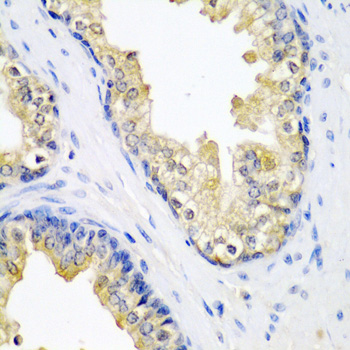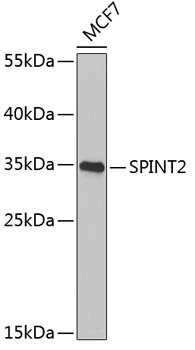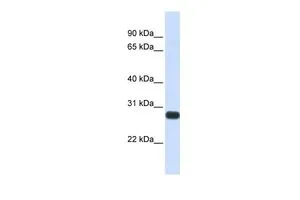![Various whole cell extracts (30 microg) were separated by 12% SDS-PAGE, and the membrane was blotted with HAI-2 antibody [DC16] (GTX02800) diluted at 1:1000. The HRP-conjugated anti-mouse IgG antibody (GTX213111-01) was used to detect the primary antibody. Various whole cell extracts (30 microg) were separated by 12% SDS-PAGE, and the membrane was blotted with HAI-2 antibody [DC16] (GTX02800) diluted at 1:1000. The HRP-conjugated anti-mouse IgG antibody (GTX213111-01) was used to detect the primary antibody.](https://www.genetex.com/upload/website/prouct_img/normal/GTX02800/GTX02800_20201204_WB_w_23053122_846.webp)
Various whole cell extracts (30 microg) were separated by 12% SDS-PAGE, and the membrane was blotted with HAI-2 antibody [DC16] (GTX02800) diluted at 1:1000. The HRP-conjugated anti-mouse IgG antibody (GTX213111-01) was used to detect the primary antibody.
HAI-2 antibody [DC16]
GTX02800
ApplicationsImmunoFluorescence, ImmunoPrecipitation, Western Blot, ImmunoCytoChemistry, ImmunoHistoChemistry, ImmunoHistoChemistry Paraffin, Other Application
Product group Antibodies
ReactivityHuman
TargetSPINT2
Overview
- SupplierGeneTex
- Product NameHAI-2 antibody [DC16]
- Delivery Days Customer9
- Application Supplier NoteWB: 1-5 microg/ml. *Optimal dilutions/concentrations should be determined by the researcher.Not tested in other applications.
- ApplicationsImmunoFluorescence, ImmunoPrecipitation, Western Blot, ImmunoCytoChemistry, ImmunoHistoChemistry, ImmunoHistoChemistry Paraffin, Other Application
- CertificationResearch Use Only
- ClonalityMonoclonal
- Clone IDDC16
- Concentration1 mg/ml
- ConjugateUnconjugated
- Gene ID10653
- Target nameSPINT2
- Target descriptionserine peptidase inhibitor, Kunitz type 2
- Target synonymsDIAR3, HAI-2, HAI2, Kop, PB, kunitz-type protease inhibitor 2, HGF activator inhibitor 2, Kunitz domain containing protein overexpressed in pancreatic cancer, hepatocyte growth factor activator inhibitor type 2, hepatocyte growth factor activator inhibitor-2, serine protease inhibitor, Kunitz type, 2, testicular tissue protein Li 183
- HostMouse
- IsotypeIgG
- Protein IDO43291
- Protein NameKunitz-type protease inhibitor 2
- Scientific DescriptionThis gene encodes a transmembrane protein with two extracellular Kunitz domains that inhibits a variety of serine proteases. The protein inhibits HGF activator which prevents the formation of active hepatocyte growth factor. This gene is a putative tumor suppressor, and mutations in this gene result in congenital sodium diarrhea. Multiple transcript variants encoding different isoforms have been found for this gene. [provided by RefSeq, Oct 2009]
- ReactivityHuman
- Storage Instruction-20°C or -80°C,2°C to 8°C
- UNSPSC12352203
References
- Lai YJ, Chang HH, Lai H, et al. N-Glycan Branching Affects the Subcellular Distribution of and Inhibition of Matriptase by HAI-2/Placental Bikunin. PLoS One. 2015,10(7):e0132163. doi: 10.1371/journal.pone.0132163Read this paper
- Chang HH, Xu Y, Lai H, et al. Differential subcellular localization renders HAI-2 a matriptase inhibitor in breast cancer cells but not in mammary epithelial cells. PLoS One. 2015,10(3):e0120489. doi: 10.1371/journal.pone.0120489Read this paper




![Untreated (-) and treated (+) MCF-7 whole cell extracts (30 microg) were separated by 12% SDS-PAGE, and the membrane was blotted with HAI-2 antibody [XY9] (GTX02801) diluted at 1:1000. The HRP-conjugated anti-mouse IgG antibody (GTX213111-01) was used to detect the primary antibody.](https://www.genetex.com/upload/website/prouct_img/normal/GTX02801/GTX02801_20201204_WB_treatment_Tunicamycin_w_23053122_646.webp)

![WB analysis of HEK293 expressing human HAI-2 using GTX52776 HAI-2 antibody [3S24].](https://www.genetex.com/upload/website/prouct_img/normal/GTX52776/GTX52776_20191119_WB_w_23060900_584.webp)
